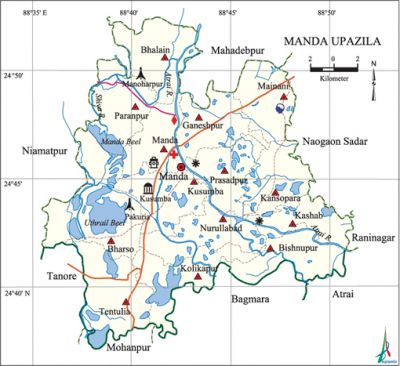Manda Upazila
Manda Upazila (naogaon district) area 375.94 sq km, located in between 24°37' and 24°53' north latitudes and in between 88°35' and 88°51' east longitudes. It is bounded by mahadebpur upazila on the north, baghmara and mohanpur upazilas on the south, naogaon sadar, raninagar and atrai upazilas on the east, niamatpur and tanore upazilas on the west.
Population Total 352560; male 178853, female 173707; Muslim 317807, Hindu 32302, Buddhist 287, Christian 18 and others 2146.
Water bodies Main rivers: atrai, Shiva; Manda and Uthrail beels are notable.
Administration Manda Thana was formed in 1943 and it was turned into an upazila in 1987.
| Upazila | ||||||||
| Municipality | Union | Mouza | Village | Population | Density (per sq km) | Literacy rate (%) | ||
| Urban | Rural | Urban | Rural | |||||
|
- |
14 |
299 |
291 |
11591 |
340969 |
938 |
53.5 |
40.3 |
| Upazila Town | ||||||||
|
Area (sq km) |
Mouza |
Population |
Density (per sq km) |
Literacy rate (%) | ||||
|
7.54 |
6 |
11591 |
1537 |
53.52 | ||||
| Union | ||||
| Name of union and GO code | Area (acre) | Population | Literacy rate (%) | |
| Male | Female | |||
|
Kashab 47 |
5205 |
9871 |
9667 |
42.98 |
|
Kalikapur 33 |
6870 |
11377 |
11030 |
37.82 |
|
Kansopara 40 |
6491 |
11828 |
11680 |
40.89 |
|
Kusumba 54 |
6834 |
17763 |
17112 |
39.02 |
|
Ganeshpur 27 |
6540 |
12935 |
12327 |
39.05 |
|
Tentulia 94 |
8718 |
12992 |
12569 |
45.32 |
|
Nurullabad 74 |
6104 |
13770 |
13512 |
39.73 |
|
Paranpur 81 |
7188 |
13264 |
13015 |
33.31 |
|
Prasadpur 88 |
6430 |
11423 |
11207 |
42.77 |
|
Bishnupur 20 |
6453 |
9996 |
9529 |
47.93 |
|
Bharso 13 |
13309 |
17029 |
16444 |
39.52 |
|
Bhalain 6 |
7594 |
11296 |
11168 |
38.72 |
|
Manda 67 |
5843 |
14433 |
14000 |
42.04 |
|
Mainani 61 |
5843 |
10876 |
10447 |
44.24 |
Source Bangladesh Population Census 2001, Bangladesh Bureau of Statistics.

Archaeological heritage and relics Six-domed Kushumba Shahi Mosque (1558), Thakur Manda Raghunath Temple, Neel Kuthi at Satihat.
History of the War of Liberation In August 1971 the Pak army killed 128 persons at village Pakuria under Bharso union of the upazila and buried them in a mass grave. Besides, the Pak army conducted mass killing and heavy plundering in the upazila and also set many houses on fire.
Marks of the War of Liberation Mass grave 1 (Manoharpur), mass killing site 1 (Pakuria).
Religious institutions Mosque 922, temple 21, church 2, sacred place 1.
Literacy rate and educational institutions Average literacy 40.7%; male 48%, female 33.3%. Educational institutions: college 13, secondary school 75, primary school 207, kindergarten 2, madrasa 13. Noted educational institutions: Manda Momen Sahana Degree College (1970), Mainani Multilateral High School (1895), Manda Pilot High School (1914), Pajor Bhanga Primary School (1901), Majidpur Fazil Madrasa (1970).
Cultural organisations Library 1, club 41, cinema hall 4, playground 146.
Main sources of income Agriculture 78.75%, non-agricultural labourer 2.28%, industry 0.68%, commerce 8.99%, transport and communication 1.86%, service 2.69%, construction 0.49%, religious service 0.09%, rent and remittance 0.08% and others 4.09%.
Main crops Paddy, wheat, mustard, potato, sugarcane, sesame, kalai, vegetables.
Extinct or nearly extinct crops Kaun, barley, linseed, arahar,
Main fruits Mango, litchi, banana, jackfruit, guava, papaya.
Fisheries, dairies and poultries Fishery 6, dairy 79, poultry 95.
Communication facilities Pucca road 42 km, semi-pucca road 38 km, mud road 237 km; waterway 14 nautical miles.
Extinct or nearly extinct traditional transport Palanquin, horse carriage, bullock cart.
Noted manufactories Rice mill, welding factory.
Cottage industries Goldsmith, blacksmith, potteries, bamboo work.
Hats, bazars and fairs Hats and bazars are 30, fairs 5, most noted of which are Chaubadia Hat, Shabai Hat, Deluabari Hat, Sati Hat and Prasadpur Hat.
Main exports Paddy, wheat, sugarcane molasses, banana, papaya.
Access to electricity All the unions of the upazila are under rural electrification net-work. However 15.86% of the dwelling households have access to electricity.
Sources of drinking water Tube-well 93.22%, tap 0.37%, pond 0.21% and others 6.2%. The presence of arsenic has been detected in shallow tube-well water of the upazila.
Sanitation 12.98% (rural 12.19% and urban 36.58%) of dwelling households of the upazila use sanitary latrines and 31.91% (rural 32.28% and urban 21.02%) of dwelling households use non-sanitary latrines; 55.11% of households do not have latrine facilities.
Natural disasters Many people were victims of the famine of 1770 (popularly known as manvantar of 1176, BS) and the epidemic following the floods of 1962 and 1995.
Health centres Upazila health complex 1, health and family planning centre 9, family planning centre 12, community clinic 49.
NGO activities Operationally important NGOs are brac, asa, CARE, thengamara mahila sabuj sangha. [Md.Abu Rashed]
References Bangladesh Population Census 2001, Bangladesh Bureau of Statistics; Cultural survey report of Manda Upazila 2007.
